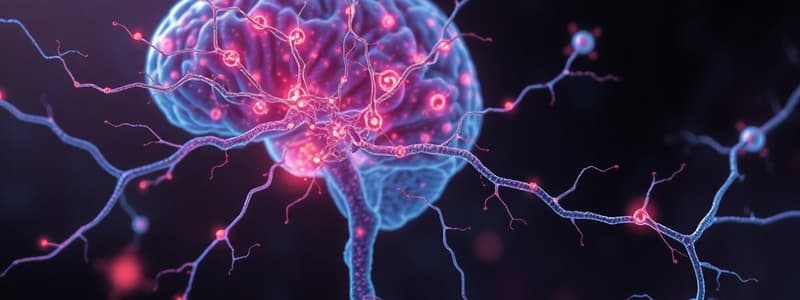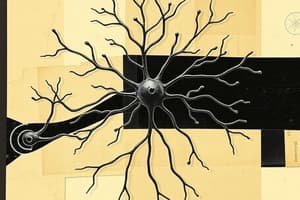Podcast
Questions and Answers
Which type of cells are capable of continuing to replicate throughout life?
Which type of cells are capable of continuing to replicate throughout life?
- Retinal Cells
- Labile Cells (correct)
- Stable Cells
- Permanent Cells
What distinguishes stable cells in the nervous system?
What distinguishes stable cells in the nervous system?
- They replicate continuously without any stimuli.
- They do not replicate at all.
- They can only replicate in prenatal stages.
- They replicate only with specific stimuli. (correct)
What is a key factor that defines the potential for regrowth in axonotmesis?
What is a key factor that defines the potential for regrowth in axonotmesis?
- Presence of a glial scar.
- Complete severance of the nerve.
- Damage to the axon without complete loss of the endoneurium. (correct)
- Only the myelin sheath is damaged.
Which of the following injury classifications indicates that the axon and surrounding structures are severely damaged, making regrowth unlikely?
Which of the following injury classifications indicates that the axon and surrounding structures are severely damaged, making regrowth unlikely?
What is one of the primary reasons CNS neurons fail to recover from injury?
What is one of the primary reasons CNS neurons fail to recover from injury?
What process occurs following axonotmesis in response to injury?
What process occurs following axonotmesis in response to injury?
Which of the following can lead to cell damage or death in the CNS?
Which of the following can lead to cell damage or death in the CNS?
Which of the following best describes retrograde degeneration?
Which of the following best describes retrograde degeneration?
What is the primary function of neurons within the nervous system?
What is the primary function of neurons within the nervous system?
Which of the following statements about neuroglia is correct?
Which of the following statements about neuroglia is correct?
Which type of cell is responsible for myelination in the peripheral nervous system?
Which type of cell is responsible for myelination in the peripheral nervous system?
What is the role of Nodes of Ranvier in neuron function?
What is the role of Nodes of Ranvier in neuron function?
Which neuron type primarily conveys sensory information from the periphery to the central nervous system?
Which neuron type primarily conveys sensory information from the periphery to the central nervous system?
Which cells in the CNS are primarily involved in immune responses and debris clearance?
Which cells in the CNS are primarily involved in immune responses and debris clearance?
What distinguishes central nervous system neuroglia from peripheral nervous system neuroglia?
What distinguishes central nervous system neuroglia from peripheral nervous system neuroglia?
What role do astrocytes play in the central nervous system?
What role do astrocytes play in the central nervous system?
Flashcards are hidden until you start studying
Study Notes
Central Nervous System (CNS)
- The CNS is comprised of the brain and spinal cord.
- The CNS receives, interprets, and responds to information from the body.
- It regulates the autonomic nervous system.
- It is also responsible for learning, cognition, and memory.
Peripheral Nervous System (PNS)
- The PNS encompasses all nervous system components outside of the brain and spinal cord.
- This includes cranial nerves.
- The boundary between the spinal cord and the PNS is the intervertebral foramen.
Nervous System Cells
- There are two main types of nervous system cells: neurons and neuroglia.
- Neurons are the parenchymal cells that transmit signals through synapses.
- Neuroglia provide support for neurons, such as myelination.
Types of Neurons
- Neurons can be grouped into different types based on their structure and function.
- These include:
- Multipolar: Possess a single axon and multiple dendrites.
- Bipolar: Possess a single axon and single dendrite.
- Unipolar: Possess a single process that functions as both an axon and dendrite.
Neuroglia (CNS)
- Microglia: Immune cells of the CNS that scavenge debris and pathogens.
- Astrocytes: Provide structural support, regulate blood flow, and participate in neurotransmitter uptake.
- Oligodendrocytes: Form myelin sheaths around axons in the CNS.
- Ependymal Cells: Line ventricles of the brain and central canal of the spinal cord, produce cerebrospinal fluid.
Neuroglia (PNS)
- Schwann Cells: Form myelin sheaths around axons in the PNS.
- Satellite Cells: Surround neuronal cell bodies in the PNS, providing support and regulation.
Neuronal Resilience
- Neuronal resilience refers to the ability of neurons to withstand injury and recover.
- Labile cells: continuously replicate throughout life.
- Stable cells: can replicate with appropriate stimulus.
- Permanent cells: cannot replicate after birth.
Neuroplasticity
- Neuronal resilience is partly due to neuroplasticity, which is the ability of the nervous system to compensate for destroyed neurons.
- Although neurons are permanent cells, they can potentially repair damaged axons in peripheral nerves.
- For a neuron to be killed, the cell body must be destroyed, not just the axon.
Fatal Axonal Injury
- Fatal axonal injury in peripheral nerves is classified by the level of injury.
- Axonotmesis: the axon is damaged but the myelin sheath remains intact. It has potential for regrowth through Wallerian degeneration and axonal sprouting.
- Neurotmesis: the axon, myelin sheath, and endoneurium are damaged or destroyed. Regrowth is unlikely.
CNS Neuron Repair
- CNS axons, unlike PNS axons, typically don't regenerate due to:
- Inhibitory molecules: prevent regrowth.
- Glial scar: forms around the lesion, blocking axon regrowth.
- Less growth-related gene expression: compared to PNS neurons.
Retrograde Degeneration
- If a CNS axon is fatally injured or a PNS axon damage is too close to the cell body, retrograde degeneration can occur. This is the death of the neuronal cell body.
Causes of Cell Damage/Death in the CNS
- CNS neurons are sensitive to oxygen reduction and blood sugar variations.
- Major causes of cell damage or death include:
- In Utero: Maternal illness, exposure to toxins, or genetic factors can contribute to CNS injury.
- Birth-related: Complications during birth, such as hypoxia or birth trauma, can damage the CNS.
- Fractures/Dislocations of Supporting Bones: Traumatic injuries can directly damage CNS tissue or indirectly impact neuronal function.
- Compression: Pressure on the brain or spinal cord can damage nerves and disrupt blood flow.
Studying That Suits You
Use AI to generate personalized quizzes and flashcards to suit your learning preferences.




